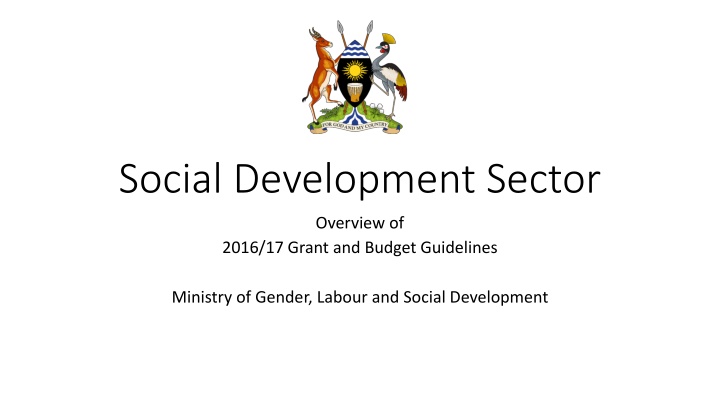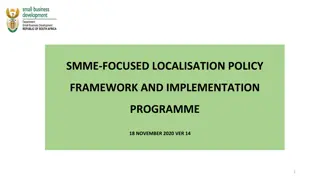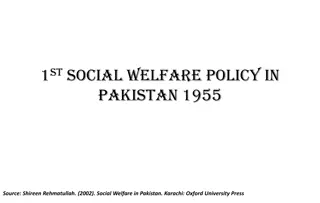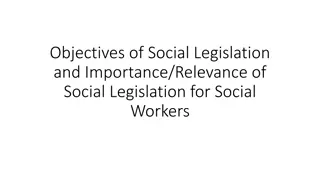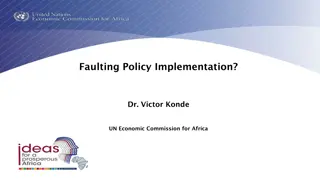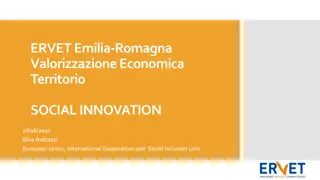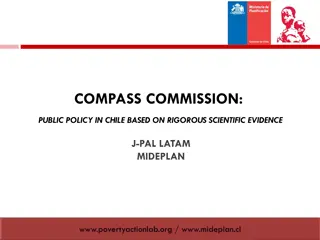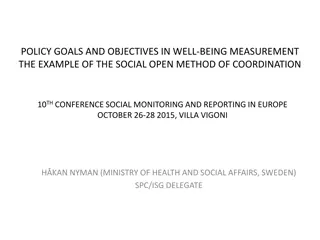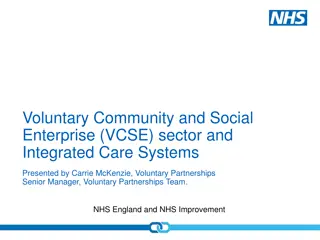Social Development Sector Overview and Policy Objectives
This overview outlines the grant and budget guidelines for the Ministry of Gender, Labour, and Social Development in 2016/17. It covers sector objectives, outcomes, policy priorities, and budget requirements, emphasizing empowerment, gender equality, and inclusive growth. The sector aims to promote decent employment, enhance community participation, empower youth, and ensure equal opportunities for all. Key outcomes include increased workforce participation, marginalized group engagement, and strengthened social protection programs.
Download Presentation

Please find below an Image/Link to download the presentation.
The content on the website is provided AS IS for your information and personal use only. It may not be sold, licensed, or shared on other websites without obtaining consent from the author.If you encounter any issues during the download, it is possible that the publisher has removed the file from their server.
You are allowed to download the files provided on this website for personal or commercial use, subject to the condition that they are used lawfully. All files are the property of their respective owners.
The content on the website is provided AS IS for your information and personal use only. It may not be sold, licensed, or shared on other websites without obtaining consent from the author.
E N D
Presentation Transcript
Social Development Sector Overview of 2016/17 Grant and Budget Guidelines Ministry of Gender, Labour and Social Development
1. Sector Objectives 2. Sector Outcomes 3. Sector Mandate 4. Sector Policy Priorities 5. Structure and Purpose of Sector Transfers 6. Allocation Formulae 7. Overview of Budget Requirements 8 Service Delivery Units 9 9 Other Sectoral Issues 2
1.00 Sector Policy Objectives 1.1 1.2 Promote decent employment opportunities and labour productivity; Enhance effective participation of communities in the development process; Enhance the resilience and productive capacity of the vulnerable persons for inclusive growth; Empower youth to harness their potential and increase self- employment, productivity and competitiveness; Promote rights, gender equality & equity and women empowerment in the development process; Strengthen the performance of the SDS institutions; and Redress imbalances and promote equal opportunity for all. 1.3 1.4 1.5 1.6 1.7 3
2.0 Sector Outcomes 2.1 Increased proportion of workforce in productive and decent employment activities; Increased percentage contribution of creative and cultural industries to economic development ; Increased percentage of households accessing and participating in development activities; Increased percentage of marginalized groups participating in and benefiting from sustainable development initiatives; Increased percentage of beneficiaries of social protection programmes with the capacity to meet their basic needs and access social services; 2.2 2.3 2.4 2.5 4
2.00 Sector Outcomes 2.6 2.7 Informed households accessing and participating in development a; Increased percentage of empowered Women that have ownership, access, and control of resources ; Increased Women s representation in decision making at all levels ; Increased number of sectors and Local Governments that have mainstreamed gender and rights concerns in policies, plans and Budgets; Reduced prevalence of GBV (Physical, Sexual, Defilement of Children and FGM); 2.10 Increased protected rights of vulnerable groups; and 2.11 Visible, strong, sustainable, efficient and effective social development institutions supporting service delivery for the SDS. 2.8 2,8 2.9 5
3.0 Sector Mandate 3.1To mobilize and empower communities to harness their potential while, protecting the rights of vulnerable population groups; 3.2 Promotes issues of labour productivity and employment, social protection, gender equality & equity, human rights, culture and empowerment; 3.3 Overall, the sector aims to achieve a better standard of living, equity and social cohesion; 3.4 Responsible for the protection and promotion of the rights of the vulnerable population, addressing gender inequalities, ensuring cultural growth, labour and employment as well as community mobilisation and empowerment. 3.5 Therefore, the Sector plays a fundamental role in creating demand for social services and laying a foundation for other sectors to improve their outcomes. 6
4.0 Sector Policy Priorities 4.1 The Social Development Sector provides community level activities to reduce poverty and plays a pivotal role that creates the necessary conducive environment for the other sectors to effectively deliver services to all sections of the population. 4.2 The overall planning framework is the Social Development Sector Strategic Investment Plan (SDIP) that directly contributes to the National Development Plan II. The SDIP restates government s commitment to achieve growth with equity. 4.3 NDP II was also informed by the Sector Issues Paper. This paper will also inform the update of the sector plan which is currently under development as the last year of SIDP II is 2015/16 7
5.0 Structure and Purpose of Sector Transfers Grant Social Development Services NWR Purpose To support decentralized services and community-level action to reduce poverty 8
6.0 Key Variables Used in Allocation Formulae Variable Hard to Reach, Hard to Stay Land Area (Hectares) Population Poverty Headcount Promotes equalisation, recognising that the poorest regions may benefit most from the services provided Justification Proxy for cost of providing services far in hard to reach areas Proxy for cost of providing services in a larger district. Estimates the need 9
7.0 Service Delivery Units Area Narrative and performance contract Overview of Work plan Revenues and Expenditure Requirement The budget narrative summarises information on revenue, expenditure and key outputs in the performance contract. Total Work plan revenues and expenditures balance and are divided correctly between wage, non-wage recurrent, GoU and donor development. Salaries of permanent staff must not exceed the overall staff and budget ceilings, Salaries must be funded from the unconditional wage grant. Salary allocations to for permanent staff must be according to the filled posts within the approved structure, recruitment plan and salary scales. Salaries and Related Costs 10
7. Service Delivery Units(cont.) Area Salaries and Related Costs Human Resource Requirements Wage allocations must meet minimum staffing requirements. District Head Quarters must budget for: o 1 District Community Development Officer o 2 Senior Community Development Officers o Senior Probation Social Welfare Officer (Prob. Act Cap 122) o 1 Principal Labour Officer o 1 Senior Labour Officer o 1 Labour Officer Municipal Head Quarters must budget for: o 1Principal Community Development Officer o 2 Senior Community Development Officers o Senior Probation Social Welfare Officer (Prob. Act 1963) o 1 Principal Labour Officer o 1 Senior Labour Officer o 1 Labour Officer 11
7. Service Delivery Units (cont.) Area Salaries and Related Costs Human Resource Requirements Each district sub-county must budget for: o 1 Community Development Officer o 1 Assistant Community Development Officer o 1 Probation Officer Each municipal division must budget for: o 1 Community Development Officer o 1 Assistant Community Development Officer o 1 Probation Officer o 1 Labour Officer 12
7.0 Service Delivery Units (cont.) Area Lower Local Services Requirement The budget must allocate a minimum of 70% of sector non-wage recurrent grant to Lower Local Governments to fund CDOs and CDWs to implement programmes for PWDs, Community Based Rehabilitation and Youth Councils. Local governments may budget up to a maximum of 10% of the non-wage recurrent budget for monitoring and supervision. Monitoring and Management of Service Delivery Capacity development The sector conditional grants cannot be used to budget for capacity building. However, local governments may provide for capacity building using their own local revenue, the DDEG, and other transfers. Capacity building activities should be consistent with the positive and negative lists. Local governments may budget for capital investment using the DDEG or reallocations from wage and non-wage conditional grants. At most, 10% of budget allocations to Social Development infrastructure and rehabilitation can be used to finance investment service costs, such as bills of quantities or economic impact assessments. Local governments must not budget for investments specified in the negative list. 13 Capital Investments
8.0 Other Sectoral Issues 1.0 The structure of the department does not allow for career development; 2.0 OSH function is not decentralised, therefore, there is need for the establishment of regional offices to enforce OSH Standards; 3.0 The post of labour officer is a requirement as stipulated in the Employment Act 2006; 4.0 It is a requirement by the World Bank that all infrastructure projects should be inspected for labour and OSH social safeguard framework before accessing funds; 5.0 Insufficient funding to the sector; 6.0 Inadequate transport 14
